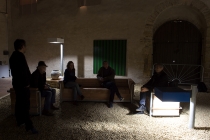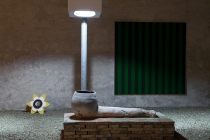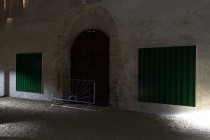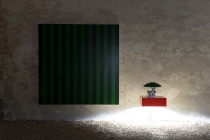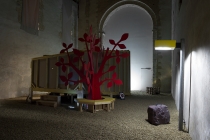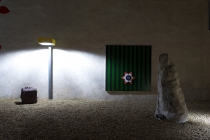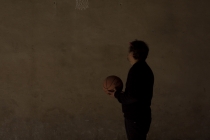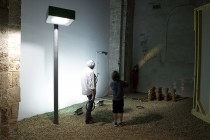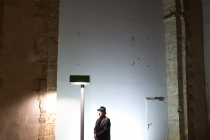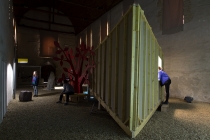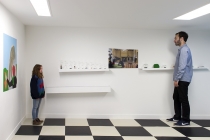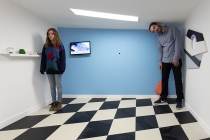Chapelle du Genêteil, Château-Gontier, France.
30th May to 30th August 2015.
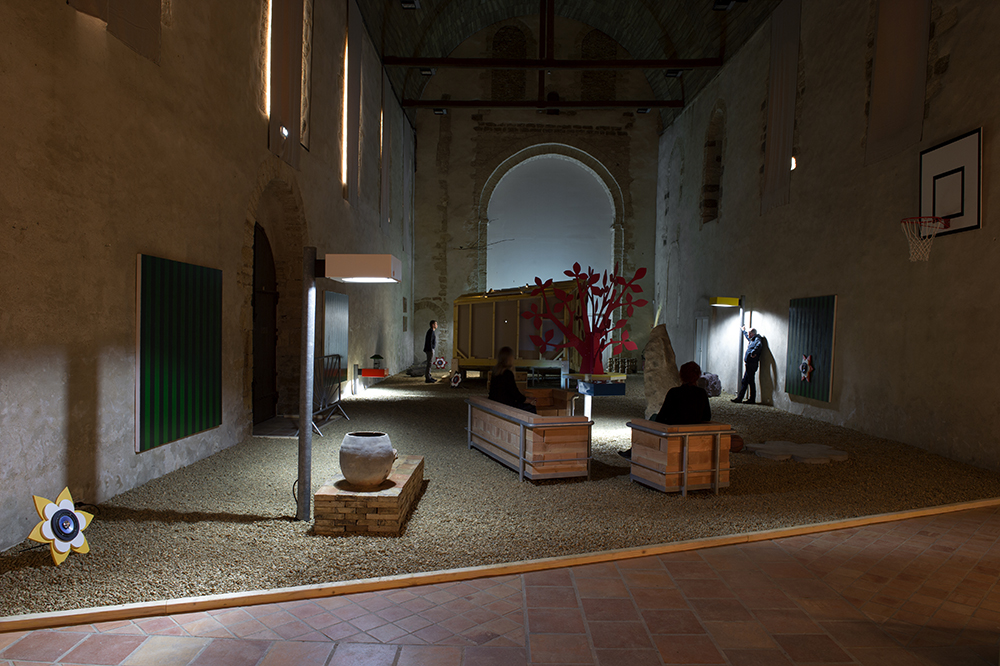
When Anabelle Hulaut and David Michael Clarke concoct a project with their four hands, they naturally attach themselves to the encounter : their encounter with art, their own romantic encounter, but also the «rendez-vous» between two individual artistic universes artistiques, developed for the occasion into a form of complicit exhibition. A process both distant and intimate, critical and emotional, with subjective interaction as a motor, that functions like a «cadavre exquis», where each artist lays down an idea, a gesture or an object, without prematurely projecting a definitive plan of the ensemble.
If one looks for other analogies to conjure up the experiments lead by these two artists at the Chapelle du Genêteil, the image of a landscaped garden complete with follies (1) comes to mind : a park composed with objects (natural or architectural, ornamental or sculptural) who, by their placement and by their order, assure the articulation of points of view and punctuate different paths, paths to walk, paths of thought. This delicious type of space (2), that ushers in surprises, that allows us to drift into the world of the imagination, resonates with title of the exhibition : OUTSIDE-IN, from the exterior to the interior, or how to recreate a fantastical and offbeat garden in the heart of an exhibition space. Here we are in the dynamic yet slippery world of metamorphosis, where paths fork into two and the different artworks ricochet off each other in a quite unpredictable manner.
In the soft twilight, where day meets night and reality meets fiction, the visitor discovers a universe constructed through the poetry of chance, through paradox, blurred boundaries between the world of art and daily life. Each work is a hypothesis of escape : the Thorn-Holophane lamp posts that were once adorned the streets of Château-Gontier are here, reinterpreted as modernist sculptures; a bench and two chairs made from galvanized steel and Douglas pine, bring together the original LC2 designs by Le Corbusier with the robust aesthetic of urban furniture. Elsewhere, a concrete shape on the door beneath a basketball hoop subtly brings to mind the «bulle à six coques» by Jean-Benjamin Maneval, an experimental avant-garde housing project … Between inside and outside, each work plays out its hybrid and changing character, its referential double nature.
Beyond these references (Buren, Le Corbusier, Judd, Maneval, etc.) more or less discernable, is the question of the «body» : the furniture, but also the guitar, just left there, or the ball just ready to be bounced, act as invitations, encouragements to «live» the space in a light and unusual manner. Playtime, games, also arise out of this artistic proposition: from a set of skittles based on the Chinese abacus, we pass to some sculptures that evoke the world of Serge Danot, the inventor of the Magic Roundabout, the classic children’s television programme from the 1960’s. Detective games also here to be played: so what are these glasses about? Why have they been left on this rock? What sort of investigation should we lead?
These childhood reminiscences provoke time-warps from era to era, from one space to another. The Studio Sam Moore, a penetrable sculpture with all its multiple ramifications, is also a sort of space-time capsule and surprises at the heart of the exhibition. Based on studies by the American ophtalmologiste Adelbert Ames Jr in 1946, the Studio Sam Moore produces an optical illusion that, by its very strangeness, draws our attention with a particular force. Observable as much from the outside as it is from within, this sculpture-cabin gives shelter to many objects/clues that introduce the viewer to the world of Sam Moore, a fictional character that grew out of this distorted space. Everything vibrates (spatial references and scale), and everything interpenetrates (the spaces, the objects within, and the characters that are created.
In this vast overlapping game, the question as to how we see things becomes central: the enigma of perception, the instability of appearances, the notion of the hidden image or the duality of vision. Not so much theoreticians as «receptors of sensations» (3), Anabelle Hulaut et David Michael Clarke have created a joyful story of the eye, full of rebounds and objectives that seem to happen by chance, and analogies, sometimes formal, sometimes poetic. In this narrative art, a sort of magical cause and effect, all the works lean in the end toward the following interrogation: where am I ? What can I see? What can I do?
Eva Prouteau
Translation : David Michael Clarke
Notes
1 – The first follies appeared in the English gardens at the beginning of the XVIIIe century, a practice that developed alongside that of the landscaped garden.
2 – The expression is from Henri-Léonard Bertin, who in 1762 acquired the title of «Seigneur de Chatou» and who, for twenty years worked on an extraordinary park.
3 – The expression hails from Cézanne. Noted by J. Gasquet in 1927. Conversations with Cézanne, éd. Macula, 2010, pp. 109 et 110 : «The artist is nothing else but a receptacle for sensations, all will should be silenced.»
Exhibition views: Marc Domage.
Conversation: Anabelle Hulaut & David Michael Clarke
Video guide (french dialogue): Anabelle Hulaut & David Michael Clarke.
Links:
Le Carré, National stage & Contemporary arts centre.

